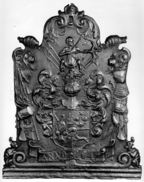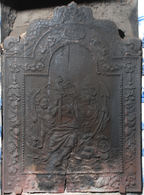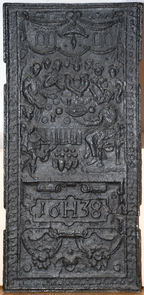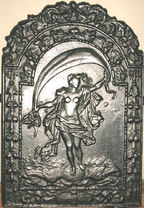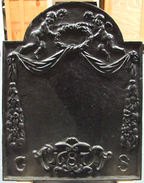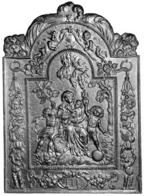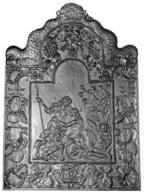-
1030
Description: Quasi-arched rectangular shape upon a moulded plinth; on a background comprising foliate swirls, a central shield, helm, coronet and elaborate mantling, with a crest of a forward facing centaur armed with a drawn bow pointed to the sinister side, and behind which are six pennons, three each side display in a v-shape; to the left, a triumph comprising a drum, draped flag on pole, concealing an arquebus, halberd and breastplate, and a broad-brimmed hat with feather; to the right, a triumph comprising a drum, a breast plate and tassets, a powder horn, and partially concealed arquebus, sword and spear, and a broad-brimmed hat with feather; at the base, a horizontal fillet with scrolled ends and squatting 'rodents'.
Notes: An uncharacteristic fireback designed and cast for the family of Joan Huydecoper (1625-1704). A variant without the base plinth and 'rodents' is in the collection of Museum Rotterdam (inv. 15224).
Inscription: ANNO 1647
Arms: Joan Huydecoper
- Decoration tags:
- rectangular with ornate arch (shape)
- complex individual (edging)
- whole carved pattern
- heraldic
- armorial
- text
- humans
- objects
Manufactured: in 1647 possibly in the Siegerland area of Germany.
Current location: Rijksmuseum, Museumstraat, Amsterdam South, North Holland, Netherlands.
Museum number: BK-1978-19 (part of the Rijksmuseum museum group)
- Attached to series:
- 'Dutch' Miscellaneous Firebacks
- Foreign armorial firebacks
-
42
Description: Arched rectangular shaped central panel with bead edging; pictorial scene of a seated female figure resting against a hurdle, holding an anchor, a child on each side of her, the one on the left standing clutching corn stalks, the one on the right sitting also holding the anchor and a circular object; a bird sits on a post; arched rectangular shaped border with fillet edging, containing floral swags suspended from a wreath; on top, a scallop shell between two dolphins.
Notes: The figure represents Hope. The theft in 1699 from a Thames-side warehouse of several firebacks, including '3 of Hope with an Anchor' may refer to this type (Post Boy 11-14 Nov. 1699).
Copies of this fireback are known.
- Decoration tags:
- 'Dutch' (shape)
- fillet (edging)
- whole carved pattern
- pictorial
- allegorical
- animals
- humans
- objects
Manufactured: in the mid- to late-17th century in the Siegerland area of Germany.
Current location: in private hands, Cuckfield, West Sussex, England.
- Attached to series:
- 'Dutch' Miscellaneous Firebacks
- Hope firebacks
-
278
Description: Arched rectangular shape with fillet edging; mirrored drapery swags emanating from two wings, and terminating in elongated tassels hung from hooks; date split by wings; initials split at bottom corners.
Notes: A simple design with space for further personalised decoration.
Copies of this fireback are known.
Inscription: 16 87 / C S
- Decoration tags:
- rectangular with round arch (shape)
- cavetto (edging)
- whole carved pattern
- individual letters
- individual numbers
- heraldic
- text
- objects
Manufactured: in 1687 possibly in the Siegerland area of Germany.
Current location: Chequers, Ellesborough, Buckinghamshire, England.
- Attached to series:
- 'Dutch' Border only firebacks
-
565
Description: Rectangular; flanged edging; small guilloche pattern down each side and along the bottom; upper panel, pictorial scene of the Marriage at Cana; lower panel, inscription panel within a strapwork cartouche with flowers below.
Notes: An end stove plate with a popular scene from the New Testament - John 2.
Copies of this fireback are known.
Inscription: 16 H 38
- Decoration tags:
- rectangular (shape)
- flanged (edging)
- whole carved pattern
- pictorial
- biblical
- text
- humans
Manufactured: in 1638 possibly in the Siegerland area of Germany.
Current location: Folkestone Library and Heritage Centre, Grace Street, Folkestone, Kent, England.
(part of the Folkestone Library and Heritage Centre museum group)
- Attached to series:
- Stoveplates
- Marriage at Cana stoveplates
-
936
Description: Arched rectangular central panel with triple bead and pellet edging; semi-naked figure of Fortune, holding in her hands a billowing sheet, and standing on a ground; arched rectangular fillet border enclosing suspended swagged flowers and berries (top and sides), with indeterminate foliage on the bottom on either side of an empty cartouche; on top, symmetrical wsirled foliage.
Notes: The design is derived from an engraving by Aegidius Sadeler after a painting by Christoph Schwarz of about 1580-1600. Although not marked as such, other castings of this fireback are marked with the initials, GK, and dated to 1700.
Copies of this fireback are known.
- Decoration tags:
- 'Dutch' (shape)
- fillet (edging)
- whole carved pattern
- pictorial
- allegorical
- humans
Manufactured: in the early-18th century possibly in the Siegerland area of Germany.
Current location: in private hands Haringhuizen, Netherlands.
Citation: Elling, W. & Winkler-Borck, S., 1992, Ofen- und Kaminplatten (Vreden, Hamaland-Museum).
- Attached to series:
- 'Dutch' GK series
-
576
Description: Arched rectangular shape; stepped fillet edging; in the arch, two putti holding a wreath from which hang two swags of drapery which, passing through rings in each top corner of the plate, terminate in large tassels comprising fruit and flowers, which reach nearly to the bottom of the plate; at the bottom, the date in a central cartouche surmounted by a scallop shell, between the two initials.
Notes: The space in the middle of the plate is available for further decoration.
Copies of this fireback are known.
Inscription: G / 1687 / S
- Decoration tags:
- rectangular with round arch (shape)
- cavetto (edging)
- carved pattern panels
- text
- humans
- plants
Manufactured: in 1687 possibly in the Siegerland area of Germany.
Current location: National Maritime Museum, Greenwich, London, England.
Museum number: AAA3478 (part of the National Maritime Museum museum group)
- Attached to series:
- 'Dutch' Border only firebacks
-
83
Description: Arched rectangular shaped central panel, bead-and-pellet edging, semi-naked male figure, wearing a floral head-dress and carrying a basket of produce, initials in top corners; arched rectangular shaped border, fillet edging, symmetrical festoons of foliage, floral scrolls at base, date in an oval cartouche; on top, two putti, two dolphins and scrolled foliage, all symmetrical.
Notes: An allegory of Spring, based closely on an engraving, dated 1600, by Hendrik Goltzius (1558-1617); one of a series of large firebacks of similar date, all bearing the initials, GK.
Copies of this fireback are known.
Inscription: G K / 1700
- Decoration tags:
- 'Dutch' (shape)
- fillet (edging)
- whole carved pattern
- individual letters
- date stamp
- pictorial
- allegorical
- text
- humans
Manufactured: in 1700 possibly in the Siegerland area of Germany.
Current location: Guildford Museum, Guildford, Surrey, England.
Museum number: S,7111 (part of the Guildford Museum museum group)
Citation: Pesch, D., 1982, Herdgussplatten (Rheinland-Verlag, Koln).
- Attached to series:
- 'Dutch' GK series
-
1239
Description: Arched rectangular central panel with bead-on-fillet edging; pictorial scene of Jesus sitting at the well with the woman of Samaria standing opposite, a rural scene behind, trees on each side and clouds with sunrays above; arched rectangular border with fillet edging; central cartouche at top, with festoons of fruit, flowers and leaves suspended on each side from ribbons supported by rings; at the bottom, swirled ribbon around an oval compartment bearing the inscription 'L6C'; on top, a central cartouche from which descend a cornucopia on each side of the arch.
Notes: The scene, seen on many German firebacks and stoveplates, is from St John's gospel, chapter 4; the inscription at the bottom indicates the style of border; other firebacks with the same inscription have the same border; similar inscriptions (e.g. L7C and L8G) indicate different borders.
Copies of this fireback are known.
Inscription: L6C
Manufactured: in the mid- to late-17th century possibly in the Siegerland area of Germany.
Current location: Vreden, Nordrhein-Westfalen, Germany.
Citation: Elling, W. & Winkler-Borck, S., 1992, Ofen- und Kaminplatten (Vreden, Hamaland-Museum).
- Attached to series:
- 'Dutch' LC/G series
-
308
Description: Arched rectangular centrel panel with bead on fillet edging; central seated female with an infant in her arms, a swan at her feet and a standing child on each side, the one to her left facing the front and holding aloft a flaming heart, its foot on a ball; the child to her right facing the back, holding aloft a branch in its left hand, all on a ground with a tree behind to the right; arched rectangular border with fillet edging; at the top of the arch a cartouche from which are suspended two ribbons, each held by a putto, from which cascade flowers and fruit, each lower part hung from a ring; two putti are on each side, one climbing on the suspended ribbon, the other at its foot; at the bottom, a cartouche containing the monogram between two clusters of flowers each suspended on a ribbon tied to a scroll; on top, two descending cornucopiae.
Notes: The scene portrays Charity; the same central panel can be seen with different borders, and also exists in other versions.
Copies of this fireback are known.
Inscription: HIS
- Decoration tags:
- 'Dutch' (shape)
- fillet (edging)
- whole carved pattern
- pictorial
- allegorical
- monogram
- text
- humans
Manufactured: in the late-17th century in the Siegerland area of Germany.
Current location: Hampton Court Palace, Richmond, Greater London, England.
Museum number: 1069 (part of the Royal Collection museum group)
- Attached to series:
- 'Dutch' HIS series
- Charity firebacks
-
310
Description: Arched rectangular central panel with bead edging; pictorial scene of Venus, naked and kneeling, and Adonis, standing, holding a spear in his left hand, with Cupid to the left, and a hound and a quiver of arrows below to the right; arched rectangular border with fillet edging; descending swags of fruit and seashells enclosing the central panel; inscription in an oval cartouche at the bottom; on top, a Holy Roman Imperial crown between two mirrored dolphins, heads downward.
Notes: The scene is based on the painting (c.1635) of Venus and Adonis by Peter Paul Rubens; the initials, L8G, denote the style of border - other firebacks having the same inscription have the same border - and other borders are denoted by similar inscriptions (e.g. L6C and L7C). Von den Driesch (p.520) illustrates the same central image within an L7C border.
Copies of this fireback are known.
Inscription: L8G
- Decoration tags:
- 'Dutch' (shape)
- fillet (edging)
- whole carved pattern
- pictorial
- mythological
- text
- humans
Manufactured: in the late-17th century in the Siegerland area of Germany.
Current location: Hampton Court Palace, Richmond, Greater London, England.
Museum number: 1042 (part of the Royal Collection museum group)
- Attached to series:
- 'Dutch' LC/G series
- 'Dutch' Venus and Adonis firebacks
